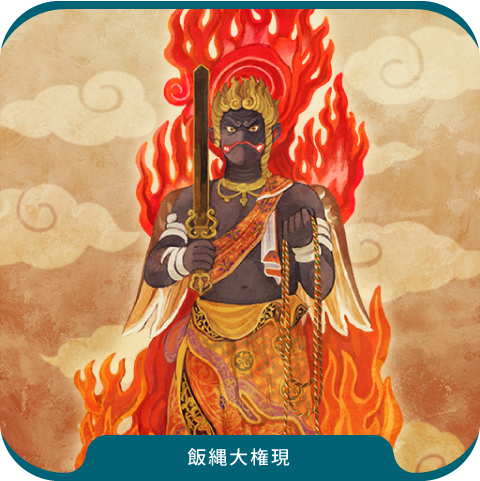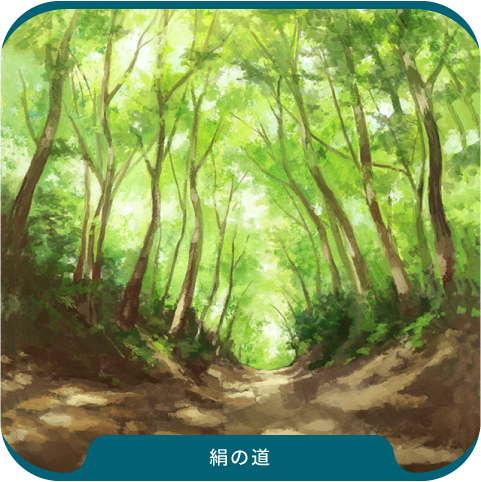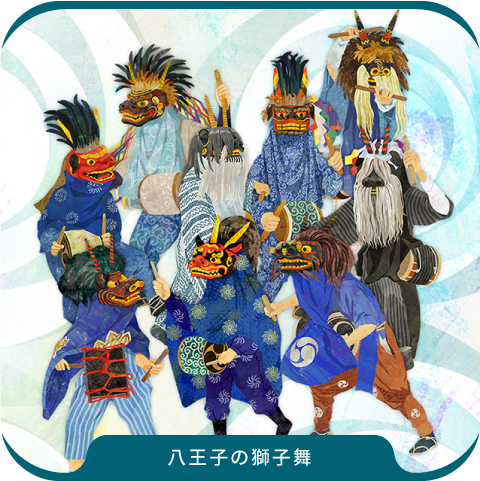


01

Hachioji is a city located to the west of Tokyo. In olden times, the silk and textile industries there had thrived, and since the raising of silkworms came hand in hand with the cultivation of mulberry trees, the worms’ primary food source, Hachioji was known as “Mulberry City.”
The city became the largest post town on the Koshu Route and developed while fostering various cultures. Its foundation dates back to the end of the Sengoku period (Warring States period; 1467–1568), when the famous Hojo family head Hojo Ujiteru, who seized control of the Kanto region, built a castle town. The silkworm farmers and silk merchants who supported the development of Mulberry City had prayed for Ujiteru’s military fortunes.
Meanwhile, the people of the area have revered Mt. Takao as sacred and have protected it with care since ancient times. On Mt. Takao, the traditional culture of Mulberry City that flourished in the Edo period (1603–1867) continues to be passed down, along with the prayers of the people.
The Story of Mulberry City is the story of the activities of the town founded by the Hojo family and the prayers of the people to the sacred Mt. Takao which continue to this day, and how the rich culture nurtured in this land will continue to be passed on to the future.






Ujiteru had previously resided in Takiyama Castle, which was situated on a gently sloping hill. However, to prepare for the advance of Takeda Shingen and Toyotomi Hideyoshi’s armies, he moved to Hachioji Castle, which was built on steep terrain with stone walls. The site of the new castle was a sacred place where Hachioji Gongen, the deity said to be the origin of the name Hachioji, was worshipped. Furthermore, as it was seen as a natural fortress facing Mt. Takao, the castle was a military stronghold that could control the mountain pass that led from Koshu to Hachioji. The fact that the Fuji Barrier that Ujiteru set up to strictly monitor the mountain pass was succeeded by the Kobotoke Barrier, considered to be the sturdiest barrier on the Koshu Route during the Edo period (1603–1867), shows just how important this location was.

Situated on Mt. Takao is Yakuoin Temple, which was founded in the Nara period (710–794). Its principal deity is Izuna Daigongen, revered as a god of war by famous military commanders. Ujiteru prayed to the deity for good fortune in battle, and protected Mt. Takao by donating land and issuing edicts forbidding the cutting of trees and bamboo. The Soto Nikki, a diary written in the Edo period, contains the Hachioji Hakkei (“Eight Scenic Spots in Hachioji”), a poem said to have been composed by Ujiteru after selecting a number of picturesque locations in the castle town. One of the eight spots, “Autumn Moon at Hachioji Castle,” describes the sight of the autumn moon shining over the whole area as seen from the castle mountain. Ujiteru may have seen an image of himself building a castle on this land that was important for both military and religious reasons, and trying to rule his domain in prosperity, reflected in the shining moon.




Ujiteru not only promoted the construction of a mountain castle as a military defense base, but also put effort into developing the castle town. The market in the castle town of Takiyama, where textile trading took place and is said to be the origin of Hachioji Textiles, was also inherited by the castle town of Hachioji. The fall of Hachioji Castle was a turning point that led to major changes in Japanese history, and the period of warring states came to an end. The castle town and market that Ujiteru established were then moved to Hachioji-shuku, which the Edo Shogunate had developed as a strategic location for the defense of the western part of Edo and as a transportation hub, inheriting the foundations of the town. Hachioji-shuku transformed into the largest post town on the Koshu Route, thanks to the silk industry. From the end of the Edo period (1603–1867) to the Meiji period (1868–1912), large quantities of raw silk were gathered from the surrounding production areas at Hachioji-shuku before being shipped to Yokohama via the Silk Road for export.

The development of the silk industry gave rise to the traditional craft of Tamaori (Tama woven fabrics). The artisans’ craftsmanship, skills, and spirit that had been cultivated alongside weaving have been passed down to the present day, bringing new life not only to the silk industry but to various other industries as well. One of the Hachioji Hakkei (“Eight Scenic Spots in Hachioji”) is called “Mountain Breeze of Mulberry City,” and it describes the scene of a bustling market with mulberry fields and a thriving silk industry. Hachioji, which is widely known as Mulberry City and has advanced as a textile town, can be said to be the results of the town planning that Ujiteru had worked on.




During the Edo period (1603–1867), the silk industry became strongly tied to the faith of the people in Takaosan Yakuoin Temple. Silkworm farmers asked the temple for talismans to protect their precious silkworms from rats. Silk merchants who dealt with raw silk and textiles centered around Hachioji-shuku, distributed Yakuoin Temple’s protection talismans to the surrounding silkworm farmers and weavers as well as wholesalers in Edo, playing a part in expanding the sphere of worship of Mt. Takao.

The people sought the blessings of Yakuoin Temple and, as a way of giving thanks for their various prayers being answered, dedicated cedar saplings to the temple. The many stone monuments erected on the mountain grounds and the dedication boards lining the approach to the temple all point to the fact that this “dedication of cedar saplings,” a major feature of the Mt. Takao faith, has continued to be carried out by people from Gunma, Saitama, and other areas with close links to the silk industry. Walking on the mountain, there are signs that the faith in Mt. Takao, which spread as a result of the development of the silk industry, is still being passed down today, and that the natural environment of Mt. Takao is being protected together with the faith. One of the Hachioji Hakkei (“Eight Scenic Spots in Hachioji”), “The Green Haze of Mt. Takao,” describes the mist that hangs over the mountain as a “green haze,” and expresses the richness and beauty of nature, as well as the solemn atmosphere of the sacred mountain. The “view of the green haze” that Ujiteru loved is full of spiritual energy and lush greenery and is one of the greatest appeals of Mt. Takao, remaining unchanged through the years.




It is said that Ujiteru was proficient in the side-blown flute, that he enjoyed lion dances which were performed to pray for a good harvest in his territory, and that he held moonlit banquets with his retainers. At the site of Hachioji Castle which Ujiteru made his own, the remains of a garden with a pond were uncovered 400 years after it fell, revealing the castle’s appearance at the time it was built. Many imported items such as Venetian lace glassware, as well as tea utensils have also been discovered, giving a sense of the cultural and artistic sophistication of the warlords of the Sengoku period (Warring States period; 1467–1568). The development of Mulberry City gave rise to a rich culture. For instance, in the Edo period (1603–1867), the inhabitants of the post town competed to make the most decorated and eye-catching floats, and the high-altitude workers who protected the town from fires inherited the Kiyari-uta (workmen’s song). Meanwhile, from the Meiji period (1868–1912) onwards, Hachioji geisha entertained silk merchants in the bustling red-light district, and the Hachioji Kuruma Ningyo (cart puppetry) evolved from a rural pastime to become a popular form of entertainment in the town. These aspects of traditional cultural developed alongside Mulberry City, and are now an indispensable part of the annual events held on Mt. Takao.

Looking out over the Kanto Plain from the top of Mt. Takao, the view of the overlapping territories of the Hojo family, the economic sphere of the silk industry centered around Hachioji, and the region of faith of Takaosan Yakuoin Temple can be seen. At the Joshinmon Gate on the approach to Yakuoin Temple, there is a signboard with the words Reiki-Manzan (“the mountain full of the power of life”), and the sound of conch shells echoing through the rows of cedars on the mountain provides a sense of the power of life. The story of the development of the fascinating culture of Mulberry City began with the Sengoku period mountain castle of Hachioji built by Ujiteru, and it shall continue on into the future through the prayers of the monks, mountain priests, and people intertwined with Mt. Takao, attracting people from all over the world.

